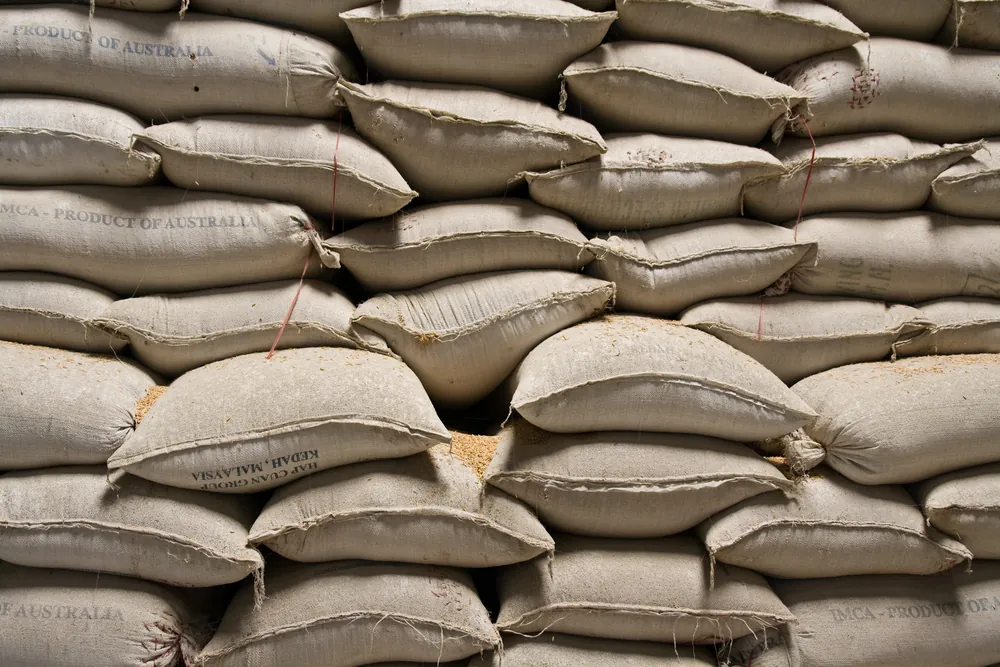
Shipping Grains
Compare freight costs online with major US carriers and save money. Use our online freight quote to get the best shipping rates and delivery times possible.
Grain Shipping Methods
FreightCenter Makes Shipping Grains Easy and Affordable. Shipping grains is done chiefly through intermodal freight within North America; in short, intermodal means using multiple modes of transportation to get from one point to another. When grain gets shipped, it most frequently uses rail and truckload freight and sometimes LTL freight during the haul if the load is small enough. This multimodal process is used over 70% of the time to transport the grain from the shipper to the consignee.
When shipping grain overseas, the ocean barges are used for most of the transport; however, to get it to the ocean carrier or NVOCC, the grain must be transported via truck, train, or drayage if the farm is near the port. The multi-model shipping of trains to the truck may be considered competition, but freight brokers such as FreightCenter use them to complement each other. This happens because the different modes of transporting grains are practical and essential in each of their ways.
We provide competitive freight shipping prices and an all-inclusive, easy-to-use shipping experience for our customers. Exceeding our customers’ expectations results in thousands of satisfied customer reviews and repeat business. We believe in the power of our customer relationships. Check out FreightCenter reviews from real customers, and learn what they have to say about their freight shipping experience!
Awards and Endorsements
- 2021, 2017 & 2016 Food Logistics’ Top Green Providers
- 2021 & 2018 Supply & Demand Chain Executives’ Pros to Know: Matthew Brosious
- 2020 & 2019 Top Food Logistics’ 3PL & Cold Storage Provider Award
- 2020 & 2019 Business Observer’s Top 500 Companies on the Gulf Coast
- 2020 & 2017 SmartWay® Transport Partner
- 2020 & 2017 Food Logistics’ Champions: Rock Stars of the Supply Chain
- 2020 Best of Palm Harbor Awards for Local Businesses
- 2017 Green Supply Chain Award from Supply & Demand Chain Executive
- 2017 Tampa Bay Business Journal Heroes at Work
- 2016, 2015, & 2012 Food Logistics Top 100 Software and Technology Providers
- 2013 Tampa Bay Business 100 by Tampa Bay Business Journal
- 2013 Top 100 Great Supply Chain Partners by SupplyChainBrain
- 2012 TIA Samaritan Award Honorable Mention
- 2012, 2011 & 2010 TBBJ Fast 50 Recipient
- 2013, 2011, & 2010 Diversity Business Top Businesses

Why Choose FreightCenter For Grain Shipping?
Here’s why you should choose FreightCenter when shipping grains:
- Expertise in Agricultural Shipping: FreightCenter has extensive experience handling agricultural products, including grains. We understand the unique requirements and challenges of grain shipping.
- Competitive Rates: Our large network of carriers allows us to offer competitive pricing for grain shipments, helping you maximize your profit margins.
- Customized Solutions: We provide tailored shipping solutions to meet the specific needs of grain shippers, whether you’re moving small batches or large quantities.
- Reliable Carriers: We work with trusted carriers experienced in transporting grains, ensuring your shipments arrive safely and on time.
- Regulatory Compliance: Our team stays updated on food safety regulations and helps ensure your grain shipments comply with all relevant standards.
- Flexible Options: Whether you need LTL, FTL, or intermodal shipping, we offer various options to suit your grain transportation needs.
- Real-time Tracking: Keep tabs on your grain shipments with our advanced tracking technology.
- Dedicated Support: Our customer service team is ready to assist you throughout the shipping process, from quoting to delivery.
- Temperature Control: For grains requiring specific environmental conditions, we can arrange temperature-controlled shipping to maintain quality.
- Nationwide Coverage: We offer shipping services across the entire United States, connecting you to markets everywhere.
Choose FreightCenter for efficient, cost-effective, and reliable grain shipping solutions tailored to your business needs.
How To Get Shipping Costs For Grain Shipping
You can save money on shipping freight by using our online freight rate quote and secure the best grain shipment rate online. This grain freight quote calculator will compare shipping rates from different grain shipping freight carriers and instantly give you a rate online that you can arrange for pick up within minutes. Using this tool will allow you to find the cheapest grain shipping rate. The cost to ship grains can be calculated instantly online and is easy to use and free of charge. You can also book your shipment online and schedule a pickup often for the following day.
If you need help with shipping various types of grains, our staff is available to help. FreightCenter will assign you a dedicated account manager that will be able to answer any questions you might have about your grain shipment, or any shipment for that matter. Shipping grains with FreightCenter is easy and will save you time and money when loading on FreightCenter.com. Please reach out to us today to see how we can help you.
Ship Grain To Feed The World
People need food every day. Freightcenters’ shippers use container shipping cross-country to export grains from the USA to other countries. When shipping feed costs go up, it makes it harder for grain producers to make a profit. The United States is the biggest producer and shipper of grains worldwide. Every year, farmers in the U.S. produce billions of bushels of corn, wheat, and other grains that all need to be moved. This abundance of grain production and grain transporting helps to feed people all over the world. The main grains produced in the US are corn, soybeans, and wheat.
In conclusion, shipping grain via freight trucking is the best for shorter distances. Rail transportation is better for shipping grain on longer distances. Lastly, barges are best for shipping grains by water routes, but they have limitations because of the rivers and water passageways.
What States Do The Most Grain Shipping?
Corn is a staple of the American diet, and five states produce and transport grains more than any other. The five states that have and ship the most corn and soybeans in America are Iowa, Illinois, Minnesota, Nebraska, and Missouri. These states make up almost half of all US corn and soybean production. The “Corn Belt” spans through Iowa to Minnesota, with Illinois standing out as well-known for its production rate among all others in this region! US wheat production is mainly from the northern and central plains. Idaho, Oregon, and Washington State also produce a lot of wheat.
What Is The Purpose Of Grain Elevators?
Grain elevators are essential to the shipping and transporting of grain. Knowing how grain elevators work can help someone who needs to move grains from one point to another. Grain shipping freight transport companies unload and load up from these enormous structures that hold the grain ready for shipping. The elevators store and dry out the grain to be shipped.
Therefore, the drying process is a critical step in grains before shipping feed. This is an essential process in the crops staying fresh and maintaining their nutrients and flavor. The elevator stores the grain until it’s time for transport. The prepping and drying of grains for transporting can take over 24 hours. Harvesting crops and storing previously harvested grains are essential to any successful harvest. Thus, farmers will only move it to the elevators when they have agreed on a sale price with a buyer.
To create value for our customers by delivering customized shipping solutions that meet their unique needs and to fulfill shipping demands from simple to complex with expertise, guidance and ingenuity.
Trust the experts at FreightCenter to give you the best prices and the most comprehensive options for all your LTL freight shipping needs.
We deliver optimized solutions for full or partial truckloads and competitive dry van, flatbed, and refrigerated freight pricing. We can cover your full truckload shipping needs.
Nationwide Expedited Trucking services move your freight securely and rapidly. Your freight requires fast delivery; our freight shipping experts can get your shipment fast, whether in one large box or a full truckload.
The most reliable Specialized Freight Services rates from all the top carriers are just a few steps away. From white glove service to international shipping, we've got you covered.

Shipping Grains FAQs
Q. What types of grains can FreightCenter ship?
FreightCenter can arrange shipping for various grains, including wheat, corn, rice, barley, oats, and more. Whether you need bulk shipping or packaged transport, we have options to meet your needs.
Q. How does FreightCenter handle bulk grain shipments?
FreightCenter partners with carriers that are experienced in transporting bulk commodities. We coordinate with carriers to ensure the grains are transported in specialized equipment such as hopper-bottom trailers or bulk containers for safe and efficient delivery.
Q. Are there special requirements for shipping grains?
Yes, shipping grains may require specific conditions, such as moisture control, protection from contamination, and temperature regulation. FreightCenter works with carriers who understand these requirements to ensure your grains arrive in optimal condition.
Q. Can I track my grain shipment?
Yes, FreightCenter provides robust tracking tools that allow you to monitor your shipment in real-time. You’ll have visibility throughout the shipping process to ensure your grains reach their destination.
Q. Does FreightCenter offer international shipping for grains?
Yes, FreightCenter can assist with international grain shipments. We manage the logistics, including customs clearance and compliance with international shipping regulations.
Q. How are shipping costs calculated for grains?
The cost of shipping grains depends on weight, volume, distance, and any special handling requirements. FreightCenter provides detailed quotes so you can plan your logistics budget effectively.
Q. What is the typical transit time for grain shipments?
Transit times vary based on the distance and shipping method. FreightCenter will provide an estimated delivery timeline when arranging your shipment.
Q. Do I need special insurance for shipping grains?
While not always required, it is recommended to have cargo insurance for grain shipments to protect against potential losses. FreightCenter can help you secure the appropriate insurance coverage.
Q. Can FreightCenter handle small-scale grain shipments?
Yes, FreightCenter offers flexible solutions for both small-scale and large-scale grain shipments. We can assist if you’re shipping a few bags or an entire truckload.
Q. How do I book a grain shipment with FreightCenter?
Booking a grain shipment is simple. Use our online tools to request a quote, or contact our logistics experts to tailor a solution that meets your shipping needs.
